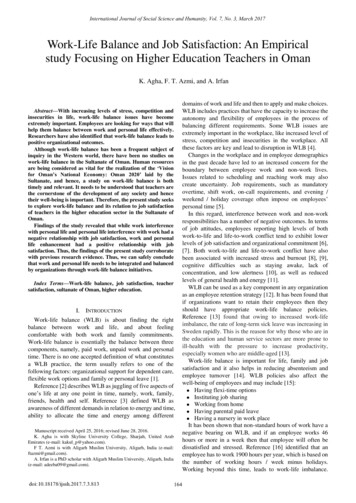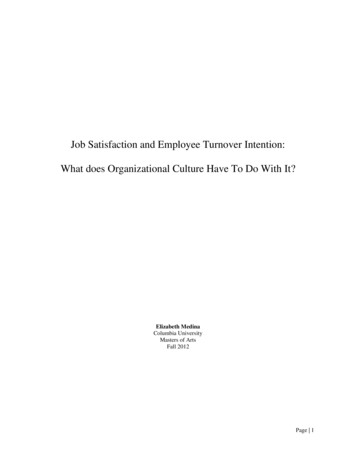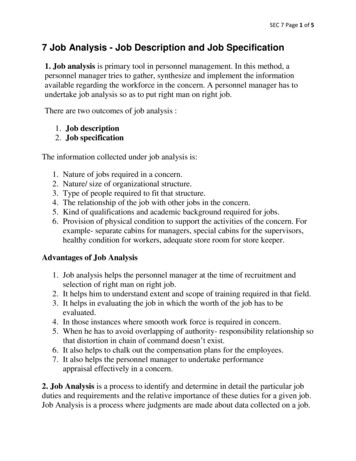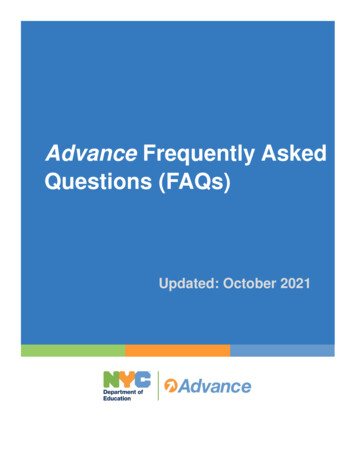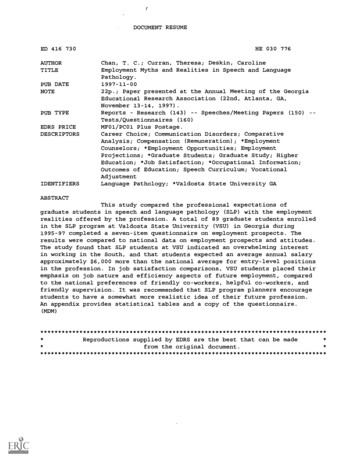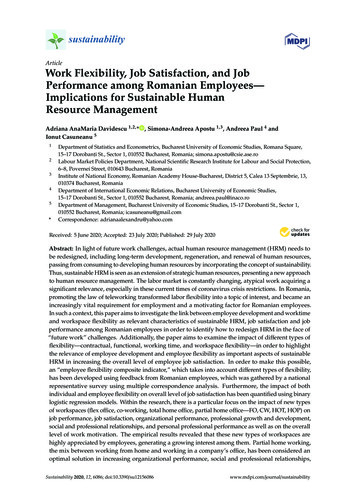
Transcription
International Journal of Social Science & Interdisciplinary Research ISSN 2277 3630IJSSIR, Vol. 2 (9), SEPTEMBER (2013)Online available at indianresearchjournals.comJOB SATISFACTION AMONG TEACHERS OF PRIVATE ANDGOVERNMENT SCHOOL: A COMPARATIVE ANALYSISTILAK RAJ*; LALITA***ASSOCIATE PROFESSOR,DEPARTMANT OF COMMERCE,M.D.U., ROHTAK**RESEARCH SCHOLAR,DEPARTMENT OF COMMERCE,M.D.U., ROHTAKABSTRACT:Job satisfaction is one of the most widely discussed issue in organizational behaviour and HumanResource Management. In present study the researcher investigated the present level of jobsatisfaction among the private and govt. school teachers. In this research, 50 Govt. and 50Private teachers, 100 in total, working in different govt. & private schools were examined. Theobtained data were analyzed based on the descriptive statistics using SPSS Version 16.Independent samplet t-test has been used in this study to analyze the job satisfaction level amongmale & female teachers and Govt. & Private school teachers. The study revealed that there is nosignificant difference in the level of satisfaction of male and female teachers. Furthermore, it wasagain revealed that there is no significant difference in the level of satisfaction of Govt. andPrivate school teachers.IntroductionJob satisfaction portrays the perception of the person towards his or her job, job relatedactivities and environment. It is a combination of psychological and emotional experiences atwork. Job satisfaction, as defined by Locke (Lutherans, 2002), is a “pleasurable or emotionalstate resulting from the appraisal of one‟s job experience”. It is often a result of the perception ofthe employee as to whether his job provides him with the outcomes he views as important. Jobsatisfaction is determined by how well the result of the job meets the expectations of theemployee or they exceed the expectations. Some important factors influencing job satisfactionmay be classified in two categories.A) Environmental factors:-Job content, Occupational level, Pay and Promotion,Workgroup and Supervision.B) Personal factors: - Age, Sex, Educational level, Marital status and Experience.Review of LiteratureThe present study examines the job satisfaction, i.e. the degree to which job features that arehighly valued by individuals are present in their work environment. Though a number of studieshave been conducted in the field of academics but a few have been undertaken to compare thejob satisfaction of male and female teachers in government & private schools. Mohdsuki and151
International Journal of Social Science & Interdisciplinary Research ISSN 2277 3630IJSSIR, Vol. 2 (9), SEPTEMBER (2013)Online available at indianresearchjournals.comSuki (2011) examined on job satisfaction and organizational commitment: The effect of genderon employee perception of job satisfaction and organizational commitment. Study revealed thatemployee‟s gender has no significant effect on his/her perception of job satisfaction and men andwomen have the same level of organizational commitment.Kumar & Bhatia (2011) mentioned that the level of job satisfaction and attitude of the teacherstowards teaching is least affected by the gender, the marital status, minimum qualification andincome group of physical Education teachers to compare the job satisfaction among PhysicalEducation teachers and their attitude towards teaching.Kumari and Jafri (2011) mentioned a study on level of Organizational Commitment of Male andFemale teachers of Secondary School to investigate the overall level of OrganizationalCommitment of Male and Female teachers of Secondary School of Aligarh Muslim University.Data analyzed by using t-test result revealed that overall percentage of female teachersOrganizational Commitment was much higher than male teachers.Zilli and Zahoor (2012) conducted a study to find out the organizational commitment amongmale and female higher education teachers and to compare the organizational commitmentamong male & female higher education teachers. Result revealed that the females hadsignificantly higher level of organization commitment.Mehta (2012) investigated on job satisfaction among teachers to know whether the perception ofjob satisfaction among teachers was affected by the type of organization (private vs. Govt.) andthe gender (male vs. female). Descriptive analysis was made to study the perception of jobsatisfaction of male vs. female and t-test was used. Result showed that there would be significantdifference in the level of job satisfaction of Govt. and private school teachers.Nagar (2012) undertook a study on "Organizational commitment and job satisfaction amongteachers during times of Burnout for developing and tests a model for Burnout and its effect onjob satisfaction on organizational commitment" Research showed that in term of job satisfaction& organizational commitment the mean score for female teachers was higher than male teachers.Objectives of the study1) To measure the level of job satisfaction of the teachers.2) To undertake a comparative study between male and female teachersregarding job satisfaction.3) To undertake a comparative study between govt. and private school teachersregarding job satisfaction.RESEARCH METHODOLOGYHypothesis There is no significant difference in the job satisfaction of govt. and privateschool teachers. There is no significant difference in the job satisfaction of male and femaleteachers.Sampling method and sample sizeThe sample of the study consisted of the teachers working in govt. and private schools restrictedto Rohtak City in the State of Haryana. A sample of 100 teachers consisting 50 Private schoolteachers and 50 govt. school teachers were taken into consideration. The sample does not include152
International Journal of Social Science & Interdisciplinary Research ISSN 2277 3630IJSSIR, Vol. 2 (9), SEPTEMBER (2013)Online available at indianresearchjournals.comall the govt. and private school teachers from all over Rohtak. Convenient sampling was used forthe present study.Research instruments and methodsFor the present study data was collected with the help of structured questionnaire. For the presentstudy Five point Likert scale is used. Questionnaire was divided in to two sections. Part- Aconsisting questions relating to personal profile of the respondents and Part-B consistingquestions relating to job satisfaction.Analysis of DataDescriptive statistics were used to measure the level of job satisfaction. The Data was analyzedby calculating percentage and frequency. Mean scores were calculated by allocating values of1,2,3,4,5 respectively to the responses „Strongly Disagree‟, „Disagree‟, „Neutral‟, „Agree‟,„Strongly Agree‟ Hence Mean score greater than 3 on any statement implies positive response ofthe respondent. Independent sample t-test was used to study the significant difference betweenthe mean score of different groups.Detailed Information of the Respondents (N 100) are as followsS. ital PrivatePRTTGTPGTMaleFemaleBelow-3030-3940-49Above l ResultsTo ascertain whether there is difference in the satisfaction of male and female teachersand satisfaction of govt. & private school teachers independent sample t-test was used. T-testvalue indicates whether any significant difference between the satisfaction of male & femaleteachers and govt. & private school teachers. t-test value greater than 0.05 indicates that there isno significant difference in the satisfaction of male teachers & female teachers and there is nodifference in the satisfaction of govt. & private school teachers.153
International Journal of Social Science & Interdisciplinary Research ISSN 2277 3630IJSSIR, Vol. 2 (9), SEPTEMBER (2013)Online available at indianresearchjournals.comTable 1.1Overall level of Teacher's SatisfactionDimensions of job satisfactionNMeanStd. DeviationEnjoy of work1004.5300.610Interesting & challenging work1004.4700.702Satisfied with job1004.3300.876Working hours of job1004.1300.981Opportunity for further rtunity to improve skills1003.80001.024Promotion1003.26001.330Good salary1003.83001.015Rewarded fairly for experience1003.8500.925Job responsibilities1004.4800.758Never think about leaving school1003.8000.994Opinion counts in the organization1003.7100.935Respect by colleagues1004.3700.705Job fully uses skills1004.0100.758Opportunity for career Development1003.8100.825Satisfied with the success1003.9300.89068.0715.25Total100Table 1.1 indicates that the Mean and Standard Deviation of teachers. Mean score greater than 3implies positive responses. Table shows that teachers have highest significant level regarding thestatement they enjoy their work (Mean 4.53, S.D .876). Result indicates that overall satisfactionof teachers is high as mean value regarding all factors is greater than 3. The study finds thatmean value for overall job satisfaction of teachers is 68.07 with a standard deviation of 15.25which indicates that the satisfaction level of majority of teachers is high.154
International Journal of Social Science & Interdisciplinary Research ISSN 2277 3630IJSSIR, Vol. 2 (9), SEPTEMBER (2013)Online available at indianresearchjournals.comTable1.2Significance of difference between mean score of various dimensions of jobsatisfaction for Male vs. Female teachersDimensions of Job satisfactionMale (N 50 )Enjoy their workInteresting & challenging workSatisfied with jobWorking hours of jobOpportunity for further advancementTrainingOpportunity to improve skillsPromotionGood salaryRewarded fairly for experienceJob responsibilitiesNever think about leaving schoolOpinion counts in the organizationRespect by colleaguesJob fully uses skillsOpportunity for career DevelopmentSatisfied with the e(N .823.624.44.063.783.94Sig. valueof ts (Table 1.2) reveals that the level of satisfaction of male teachers is high in comparison offemale teachers regarding the dimensions they enjoy their work, work is interesting &challenging, satisfied with working hours, opportunity for further advancement, good salary,rewarded fairly for experience and opportunity for carrier development but there is no significantdifference in the satisfaction of male & female teachers. For the other factors discussed abovesatisfaction level of female teachers is greater than male teachers but there is no significantdifference in the satisfaction of male & female teachers as significant value of t-test is greaterthan .05 in all cases.155
International Journal of Social Science & Interdisciplinary Research ISSN 2277 3630IJSSIR, Vol. 2 (9), SEPTEMBER (2013)Online available at indianresearchjournals.comTable-1.3Significance of difference between mean score of various dimensions of jobSatisfaction for Govt. vs. Private School teachersDimensions of Job satisfactionEnjoy their workInteresting & challenging workSatisfied with jobWorking hours of jobOpportunity for further advancementTrainingOpportunity to improve skillsPromotionGood salaryRewarded fairly for experienceJob responsibilitiesNever think about leaving schoolOpinion counts in the organizationRespect by colleaguesJob fully uses skillsOpportunity for career DevelopmentSatisfied with the successPrivate(N 50 N value 94.108.338.324.695.399.092Result (Table 1.3) reveals there is significant difference in the satisfaction level of govt. &private school teachers regarding the dimension „salary‟ and it is concluded that satisfaction levelof govt. School teachers is greater than private school teachers. For the other factors discussedabove there is no significant difference in the satisfcation level of govt. & private school teachersas significant value of t-test is greater than .05 in all cases.Conclusion and RecommendationsResults show that male respondents were found more satisfied than their femalecounterparts. The study also revealed that govt. school teachers are more satisfied than theprivate school teachers. This is due to the flexibility, security of job, high wage andindependence enjoyed by govt. school teachers.Study shows that private school teachers are very sensitive as regards wage payment. ThePrivate Sector should revise the salary structure. The authorities should include teachers at thetime of restructuring their salary. At the same time, both private and govt. schools teachers aredissatisfied on fair promotion procedures. Unbiased decisions on promotion can increase thelevel of satisfaction among the teachers in this regard.156
International Journal of Social Science & Interdisciplinary Research ISSN 2277 3630IJSSIR, Vol. 2 (9), SEPTEMBER (2013)Online available at indianresearchjournals.comAnalysis also reveals that both private and govt. school teachers show low satisfactionlevel regarding the factor „Teachers Training‟. Therefore, Authorities should organize regulartraining programmes to enrich and equip teachers with latest developments.Study further shows that level of satisfaction among both govt. and private schoolteachers is low regarding „opinion counts in the organization‟. Authorities should arrange regularformal meetings with teachers to consider their suggestions and also try to value it.Analysis also reveals that both private and govt. school teachers show low satisfactionlevel regarding the factor „opportunity for career Development‟. For increasing the satisfactionlevel of the teachers in this regard Authorities should try to provide opportunity for careerdevelopment to the teachers in this connection.Suggestion for further researchA study on the relationship between the job satisfaction and commitment among teacherscan be undertaken. A study on the level of satisfaction among teachers of rural and urban areacan further be undertaken. Comparative analysis can be made between school and collegeteachers. Similar study can be done in case of college teachers.References Bandhana, B. (2011).‟ Job satisfaction and values among kendriya vidalaya teachers‟.Journal of Education and Practice, 2(11 & 12), 17-24. Francis, G., & Jr., G.M. (1982). Job satisfaction. Human Behavior in the WorkEnvironment A Managerial Perspective (pp. 70-82). Califormia: Goodyear PublishingCompany, Inc. Santa Monica, California. Gupta, C.B. (2009). Human Resource Management. New Delhi: Sultan Chand & Sons.P30.2 Gupta, C.B. (2009). Human Resource Management. New Delhi: Sultan Chand & Sons.Pp30.6-30.7. Gowri, P. A., & Mariammal, K. (2011). College Teachers „Attitudes towards Teachingand Job Satisfaction‟. Journal of Community Guidance & Research, 28(1), 99-106. Hackman, J.R., & Oldham, G.R. (1978). Motivation through the design of work: Test of aTheory. Organizational Behaviour and Human Performance, 16, 250-279. Kumari, S., & Jafri, S. (2011). „Level of Organizational Commitment of Male andFemale Teachers of Secondary Schools‟. Journal of Community Guidance & Research,28(1), 37-47.157
International Journal of Social Science & Interdisciplinary Research ISSN 2277 3630IJSSIR, Vol. 2 (9), SEPTEMBER (2013)Online available at indianresearchjournals.com Malik, D. M. (2010). „Job Satisfaction and Organizational Commitment of Universityteachers in Public Sector of Pakistan‟. International Journal of Business andManagement, 5(6), 17-26. Mehta, D. S. (2012). „Job Satisfaction among Teachers‟. International Journal ofResearch in Commerce IT & Management, 2(4), 77-83. Mehta, D. S. (2011). „Teachers and their attitude towards teaching‟. Journal of researchin Business Management, 2(9), 32-43. Nagar, k. (2012, April). „Organizational commitment and job satisfaction among teachersduring times of Burnout‟. Vikalpa, 37.2, 43-60. Suki, N., & Suki, N. (2011). Job Satisfaction and Organizational Commitment: TheEffect of Gender. International journal of psychology research, 6(5), 1-15. Sari, H. (2004). „An analysis of burnout and job satisfaction among Turkish specialschool head teachers and teachers, and the factor effecting their burnout and jobsatisfaction’. Educational Studies, 30(3), 291-306. Zilli, A. S., & Zahoor, Z. (2012). Organizational Commitment among Male and FemaleHigher Education Teachers. Indian Journal of Psychology and Education, 2(1), 55-60.158
Dimensions of job satisfaction N Mean Std. Deviation Enjoy of work 100 4.5300 .610 Interesting & challenging work 100 4.4700 .702 Satisfied with job 100 4.3300 .876 . Table shows that teachers have highest significant level regarding the statement they enjoy their work (Mean 4.53, S.D .876). Result indicates that overall satisfaction
